Browse using the new Vinous website now. Launch →
Printed by, and for the sole use of . All rights reserved © 2015 Vinous Media
Gigondas: Triumphs, Challenges and New Beginnings
BY NICOLAS GREINACHER | OCTOBER 15, 2024
My trip to Gigondas this year was highly anticipated for three reasons. First, I was eager to see how the 2022 reds had developed, as that vintage posed significant challenges for winemakers, really putting their skills to the test. Secondly, the first 2023 reds were ready for tasting, and having sampled the wines from Châteauneuf-du-Pape and Vacqueyras just a few days earlier, I was curious to see how Gigondas measured up. But perhaps most of all, I was excited to taste the first-ever official Gigondas Blanc from the 2023 vintage, which is why I dedicated much of my report this year to the whites, giving this new category the spotlight it deserves.
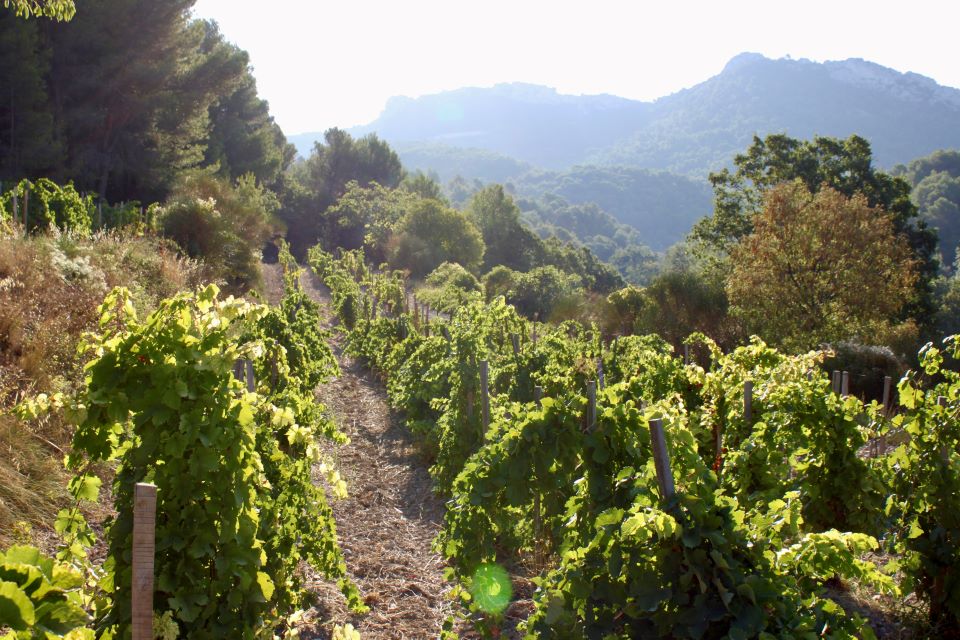
Clairette grapes in Gigondas waking up to a crisp September morning.
Welcoming Gigondas Blanc
The first vintage of Gigondas Blanc is about to reach consumers across the globe. Nineteen producers made a total of 400 hectoliters, corresponding to a little over 53,000 standard-sized 0.75-liter bottles. Interestingly, there is 60% more Gigondas Blanc than Gigondas Rosé in the inaugural 2023 vintage. With enthusiasm running high among winemakers in the appellation and consumers eager to taste the wine, many estates aim to increase the production of white grape varieties, either through new plantings or re-grafting on existing rootstocks. Expanding the Gigondas AOC area is not an option, as all the surrounding woodlands, which would need to be cleared, are protected.
Louis Barruol of Château de Saint Cosme emphasizes that young vines are needed for re-grafting, as older vines are less vigorous and have a higher incidence of disease. A look at the appellation rulebook reveals that any Gigondas Blanc must use a minimum of 70% Clairette Blanche as the principal variety. Complementary varieties, which may or may not be used, include Bourboulenc (used, for example, by Domaine Santa Duc), Clairette Rose (Domaine Saint Damien), Grenache Blanc (Domaine de Longue Toque), Grenache Gris (Domaine Les Teyssonnieres), Marsanne (Grandes Serres), Picquepoul (Domaine du Pesquier) and Roussanne (Le Mas des Flauzières). Viognier (Pierre Amadieu, Domaine de la Mavette) and Ugni Blanc are classified as accessory varieties, which can be used but must not exceed 5% of the total blend. Among the 18 wines I’ve tasted for this report, half are single-varietal Clairette, while the rest include at least one of these additional varieties.
Enthusiasts of Southern Rhône whites will have noticed by now that Clairette thrives in a warm Mediterranean climate, as demonstrated by several Châteauneuf-du-Pape winemakers. First cited in 1575, the late-ripening Clairette is ideal for regions with longer growing seasons. It excels in calcareous soils, such as the limestone-rich soils in Gigondas. Single-varietal Clairette typically yields simple, crisp white wines for early drinking. Natural acidity is moderate, with aromas including white flowers, citrus fruits and herbaceous accents like fennel.
Winemakers stress the importance of choosing the right harvest date with Clairette: “I don't think Clairette should be picked with 14% potential alcohol. I harvest at 12.5%, and here in Gigondas, at that level, about 60% of the grapes have already turned golden, which is enough to develop aromas and texture,” Louis Barruol explains. That said, the appellation mandates that Gigondas Blanc must have at least 12% alcohol. In the cellar, the wines are typically made by direct pressing of whole clusters, cold settling for up to five days and fermentation in temperature-controlled stainless-steel tanks or various sizes of oak vessels. While some winemakers use cultured yeast to start fermentation, and to enhance varietal aromatics for aromatic complementary varieties like Roussanne or Viognier, others rely solely on ambient agents.
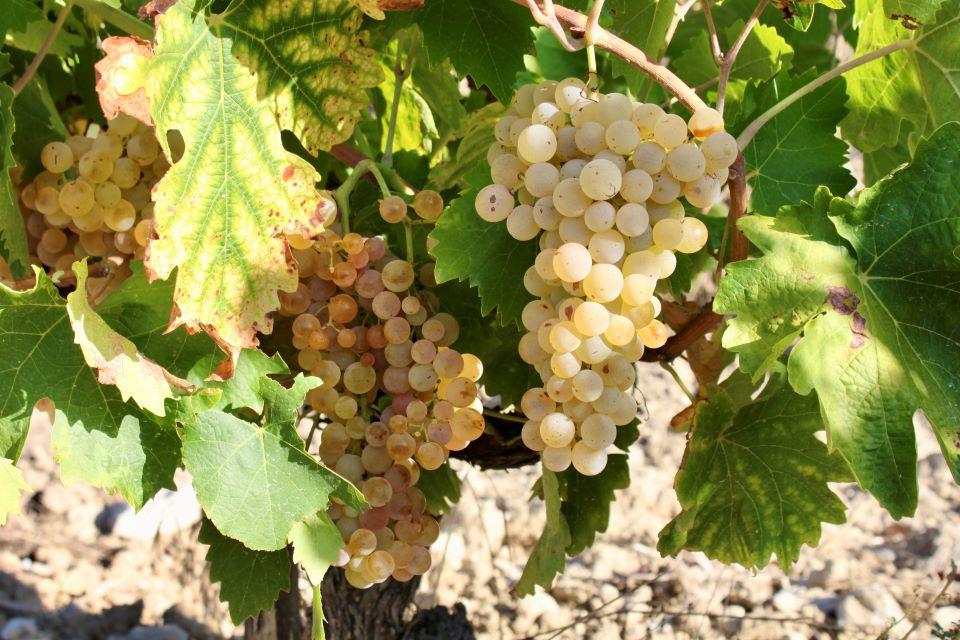
Clairette Blanche is the varietal at the heart of every Gigondas Blanc.
One of the main challenges when working with Clairette is the risk of reduction, which winemakers address by clarifying the juice well. This process reduces suspended solids in the must, including particles from stems, seeds and grape skins, all of which contain compounds that can produce off-flavors during fermentation. Benjamin Gras cites clarification as the most important step when vinifying Clairette, noting that reductive Clairette can develop markedly unpleasant aromas. Fortunately, none of the wines I tasted for this report exhibited off-putting reduction.
Malolactic conversion is usually blocked entirely or partially to preserve as much natural acidity as possible. Maturation usually lasts around ten months in various types of vessels and materials, such as new oak barriques (50% at Domaine Saint Damien for the 2023), amphorae (Pierre Amadieu), or even glass demijohns (Domaine Santa Duc). Before bottling, the wines are sulfured and filtered.
So, how are they? First, Gigondas Blanc offers a distinctive profile to white Châteauneuf-du-Pape. Gigondas Blanc is dominated by Clairette Blanche leading to wines with less richness compared to whites from Châteauneuf-du-Pape, where Roussanne plays a more significant role, resulting in more aromatic and opulent wines with a greater concentration of flavor. Secondly, Gigondas Blanc is notably crisp and refreshing, influenced by the higher altitudes and cooler Gigondas climate, particularly due to the Dentelles de Montmirail mountain range, which brings lower morning temperatures. Thirdly, winemakers with old vines, such as Château de Saint Cosme, have an advantage in producing wines with greater depth and flavor concentration.
Fourthly, based on my assessment, the finest wines of this inaugural 2023 vintage are single-varietal Clairette. That said, there are some fantastic blends, such as the Clos des Hospices from Domaine Santa Duc or the Romaine Machotte from Pierre Amadieu. Whether the decision not to mandate single-varietal Clairette in the appellation was wise remains to be seen, though. Had it been restricted to only Clairette Blanche, which is what some winemakers advocated for, it might have given Gigondas Blanc a clearer identity in the crowded world of fine wine. On the other hand, the ability to blend is a longstanding tradition in the Southern Rhône, offering varietal flexibility in an era of a changing climate and rapidly shifting consumer preferences.

Jean-Marie Amadieu of Pierre Amadieu explaining their different terroirs.
The 2023 Growing Season
The 2023 vintage began with an unusually wet end to 2022, as both November and December saw nearly double the typical amount of rainfall. However, this initial water abundance was followed by a prolonged dry spell, stretching well into spring. Rainfall did not return in significant amounts until the end of May, and by the time summer arrived, water levels were 30% lower than usual. Despite these challenges, the vines benefitted from water reserves accumulated over the wet winter months. Storms and hail made occasional appearances, although with minor impact on vineyards.
From October 2022 through January 2023, temperatures remained unseasonably mild. Thankfully, there were no late frost events, which allowed the vines to progress uninterrupted. Spring brought slightly cooler temperatures; the weather returned warmer than average by June. This provided favorable conditions for a smooth flowering, hinting at the possibility of a generous crop. As we’ll see later, higher crop loads due to successful flowering were one of the keys to success in 2023. Dry conditions persisted throughout the summer, and fungal disease pressure remained low, contributing to the overall vine health and grape quality.
July and August saw several heat waves, sometimes exceeding 40°C (104°F), as Julien Bréchet at Domaine des Bosquets reported. Due to higher crop loads from flowering, Bréchet noted that ripening was delayed compared to the 2022 vintage. The large crop loads also withstood the heat better, he added. As the summer progressed, the persistent dry conditions began to take their toll on certain vineyard blocks, particularly on Syrah planted in well-draining soils. By late August, the grapes of some of these vines started to shrivel, with the timely rains of August 27 (20mm) arriving too late to fully restore the fruit.
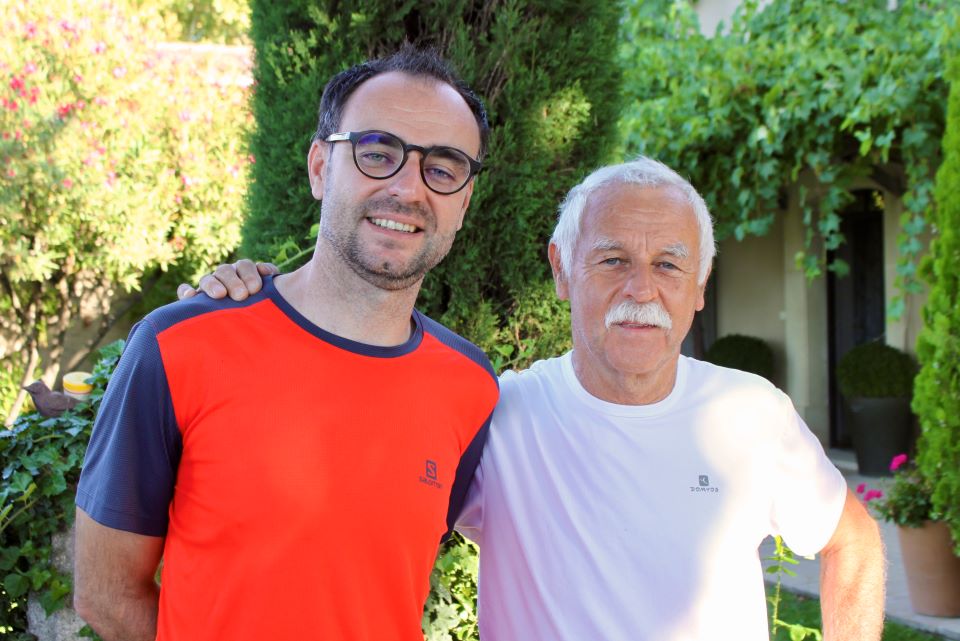
Romain Saurel with his father, Joël, at Domaine Saint-Damien.
While some winemakers confirmed the presence of occasional ripening blockages, Romain Saurel of Domaine Saint Damien witnessed a slowdown in maturation rather than a complete halt. This led to long pauses between picking different parcels and appellations: “We harvested some Côtes-du-Rhône and Plans de Dieu in Gigondas, then paused for a full 12 days, which was something new for me.” Gigondas harvest generally began in early September, with the first Syrah grapes picked around September 8th. The main effort then commenced after September 15th and concluded in the latest ripening blocks by October 10th.
Mid-September rains introduced dilution in some grapes, particularly in fruit picked shortly after the rain on September 20th. That said, the majority ripened well, aided by cool nights, which promoted aromatic development and acidity retention. These conditions produced lush wines with ripe fruit expressions and a broad aromatic spectrum. Sugar levels developed slower than in 2022, resulting in wines that are less powerful and more elegant. Some winemakers, such as Benjamin Gras from Domaine Santa Duc, tried to add more liquid to their musts by incorporating whole clusters, 50% in his case. Paul Fumoso of Domaine du Gour de Chaulé followed the same philosophy, using roughly 40%. Macerations in 2023 were often slightly longer compared to 2022 because the risk of obtaining overly tannic wines was less evident.
With winemakers reporting healthy yields between 30 and 35 hectoliters per hectare for red varieties and 40 to 45 hectoliters for whites, the 2023 vintage hinged on the 20mm rain that arrived in late August. While some blocks struggled, others thrived, yielding a vintage that reflects the dynamic growing season. The wines at this early stage are inviting and generous, showing ripe fruit and approachability, with sufficient acidity and refined tannin structures. Less dark and concentrated as the preceding vintage, 2023 produced wines of charm and balance, ideal for early enjoyment while maintaining aging potential.
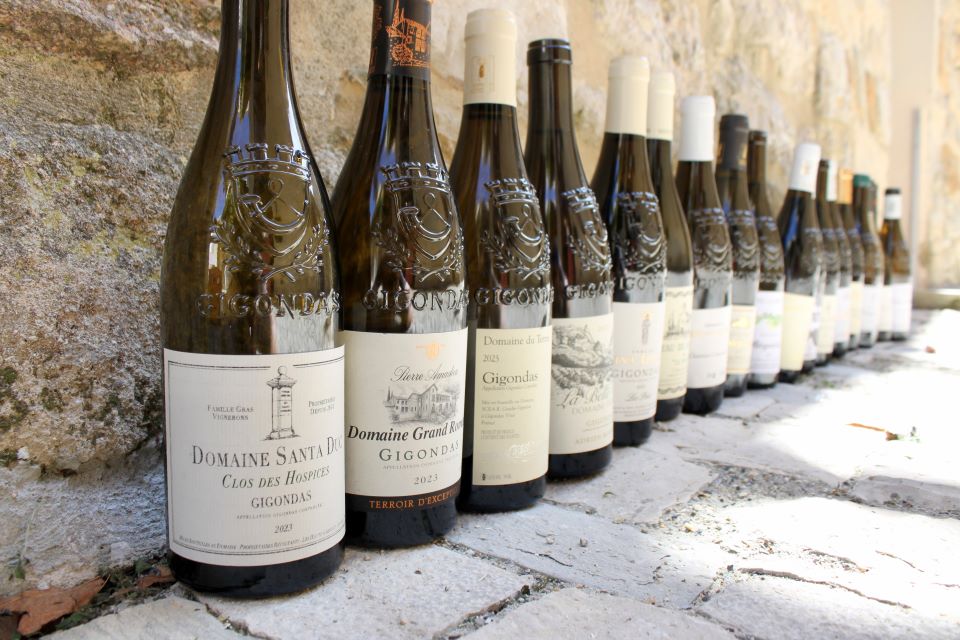
Tasting the inaugural 2023 Gigondas Blancs rendered mostly positive verdicts.
2022: The Final Verdict
Two thousand twenty-two turned out to be a very good vintage for Gigondas reds, with the crown for the wine of the year shared among three producers: Château de Saint Cosme, Domaine des Bosquets and Domaine du Gour de Chaulé. Besides these high flyers, 2022 also shows consistency across the board. Many wines where I had reservations about tannins being too astringent when tasting unfinished barrel samples last year benefited from the remainder of their élevage, coming together in harmony. That said, the marked tannic structure remains one of the prominent features of the vintage. And although 2022 beats 2021 in a landslide quality-wise, it doesn’t possess the striking balance and completeness of the 2020 vintage, which I consider one of the finest in recent Southern Rhône history. Lastly, the 2022 reds are built for the long haul and will need more time to show their full potential than the 2020, 2021 and even 2023 vintages.
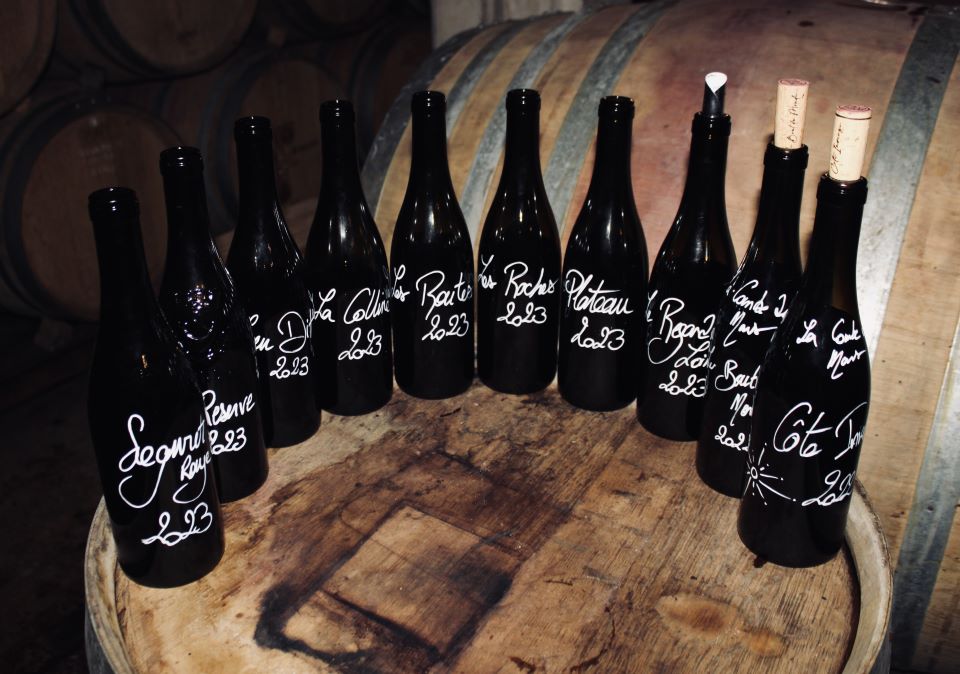
An enticing line-up at Domaine des Bosquets.
Final Thoughts
As a final remark, I’ve paid close attention this time to distinguishing red Gigondas from red Châteauneuf-du-Pape in blind tastings. Assuming the same vintage, varietal blend and winemaking techniques are used, I often find that red Châteauneuf-du-Pape exhibits a characteristic Grenache-driven smoothness, often perceived as a slight sweetness–a rarer quality in Gigondas. Even when Châteauneuf-du-Pape producers aim to avoid overly rich or sweet-tasting wines (though they are technically dry), this smooth, almost enveloping quality remains a hallmark of Châteauneuf-du-Pape. If a wine has sweeter-tasting fruit and feels smoother, richer and more opulent, it’s most probably from Châteauneuf-du-Pape. Lastly, Gigondas tannins are often less refined compared to Châteauneuf-du-Pape, which further emphasizes the smoothness attribute of the latter. That’s why Gigondas is anything but a Châteauneuf lookalike – it’s one of the most distinctive Southern Rhône Crus, worthy of recognition on its own rather than simply being compared to its more famous neighbor.
I tasted all the wines in this report in Gigondas during September 2024.
© 2024, Vinous. No portion of this article may be copied, shared or re-distributed without prior consent from Vinous. Doing so is not only a violation of our copyright, but also threatens the survival of independent wine criticism.
You Might Also Enjoy
Gigondas: The Southern Rhône Jewel Shines and Adapts, Nicolas Greinacher, January 2024
The Deep Bench of Gigondas, Josh Raynolds, January 2023
Gigondas Maintains Its Tempo, Josh Raynolds, February 2020
Show all the wines (sorted by score)
- Aimé Arnoux
- Alain Jaume
- Arnoux et Fils
- Bonpas
- Brotte
- Brunel de la Gardine
- Cellier des Princes
- Château de Montmirail
- Château de Saint Cosme
- Château du Trignon
- Château La Croix des Pins
- Château La Thébaïde
- Clos du Joncuas
- Crous St. Martin
- Dauvergne-Ranvier
- Delas Frères
- Domaine Brusset
- Domaine Cécile Chassagne
- Domaine de Cabasse
- Domaine de Coyeux
- Domaine de Fontavin
- Domaine de Font-Sane
- Domaine de la Colline Saint Jean
- Domaine de la Combe de Mars
- Domaine de la Mavette
- Domaine de Lansiôme
- Domaine de la Tête Noire
- Domaine de la Tourade
- Domaine de l'Espigouette
- Domaine de Longue Toque
- Domaine de Piaugier
- Domaine de Piéblanc
- Domaine de Saint Gens
- Domaine des Bosquets
- Domaine des Espiers
- Domaine de Verquière
- Domaine d'Ouréa
- Domaine du Cayron
- Domaine du Gour de Chaulé
- Domaine du Grand Montmirail
- Domaine du Grapillon d'Or
- Domaine du Pesquier
- Domaine du Roucas de Saint-Pierre
- Domaine du Terme
- Domaine Font Sarade
- Domaine La Bouïssiere
- Domaine La Font de Notre Dame
- Domaine La Fourmone
- Domaine La Garrigue
- Domaine La Ligière
- Domaine la Roubine
- Domaine La Soumade
- Domaine le Clos des Cazaux
- Domaine Les Aphillanthes
- Domaine Les Goubert
- Domaine Les Pallières
- Domaine Les Sibu
- Domaine Les Teyssonnieres
- Domaine Montirius
- Domaine Notre Dame des Pallières
- Domaine Paillere et Pied-Gu
- Domaine Raspail-Ay
- Domaine Saint-Damien
- Domaine Santa Duc
- E. Guigal
- Famille Deltin
- Famille Gassier
- Famille Ravoire
- Famille Tardieu
- Ferraton Père & Fils
- Gigondas La Cave
- Grandes Serres
- La Bastide Saint Vincent
- La Ferme du Mont
- Le Clos de Caveau
- Le Mas des Flauzières
- Louis Bernard
- Mas des Restanques
- M. Chapoutier
- Moulin de la Gardette
- Ogier
- Pierre Amadieu
- Pierre Henri Morel
- Réserve Mont-Redon
- Réserve Saint-Dominique
- Romain Duvernay
- Sélection Laurence Feraud
- Vidal-Fleury
